Article and maps by Sophie Benaroya, Rutgers University Sophomore
This summer I worked in Dr. JeanMarie Hartman’s Lab at Rutgers University researching factors that affect infiltration rates. More specifically I looked into how soil health indicators compare with infiltration rates in New Jersey’s Lower Raritan Watershed.
Soil health and infiltration rates are important because of their wide-reaching effects. Soil health affects groundwater, surface runoff (and hence flooding), and vegetative productivity. Unhealthy soil can lead to contaminated groundwater and waterways, a decrease in arable land, a decrease in forests and an increase in flooding risk. There are many factors that affect soil health, infiltration being one of them. Soil can be impacted by organic matter content (animal and plant matter in various stages of decomposition), soil fragments (rock fragments larger than a grain of sand) and amount of impervious surface – like roads, pavements and parking lots, and land use. Previous research has shown that urbanization has a major impact on soil health, and due the fact that the Lower Raritan Watershed is mostly urban land I felt it would be interesting to see how urbanization may have affected the soil.
To research the topic, data was downloaded from the Web Soil Survey, the official source of soil data for the United States. I analyzed these data using ArcGIS, a mapping software, and Microsoft Excel. Data on various chemical, physical and water properties on soil in the Lower Raritan Watershed was downloaded and compared to infiltration rates. As there is no data on infiltration as is; saturated hydraulic conductivity and hydrological soil groups were used as surrogates (this decision was based on the recommendations of professionals in the field). The factors that were researched were organic matter content, percentage of fragments in soil, bulk density (how compact the soil is), surface runoff class (the amount of water flow on land and is not absorbed into the soil), impervious surface cover, and land use.
First, I compared saturated hydraulic conductivity and land use. This comparison, as well as the tabular data, showed that urban areas have lower saturated hydraulic conductivity levels than Forest, Wetland and Agricultural areas.
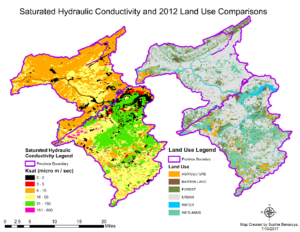
Figure 1: Saturated Hydraulic Conductivity and Land Use Comparisons
Then I compared hydrological soil groups with soil fragments percentages in the soils (Figure 2, below). Hydrological Soil Groups are groups that soil is placed in based on its surface runoff class, saturated hydraulic conductivity, and infiltrometer data. There are five classes as follows: A – High infiltration, B – Moderate infiltration, C – Slow infiltration, D – Very slow infiltration, and A/D, B/D, C/D – Dual soil groups (first letter represents drained areas, second letter represents un-drained areas.) It is evident from the map that soils with a percentage of fragments of 28% and above generally fall under soil group “D”, further insight into tabular data showed that 58.39% of soil in group D have over 28% fragments. Soil groups A and B had the majority of their soils have 6% or less fragments.

Figure 2: Hydrological Soil Groups versus Soil Fragments %
I then looked at saturated hydraulic conductivity versus surface runoff class comparisons. In this analysis (see Figure 3 below) I compared the relationship between saturated hydraulic conductivity and surface runoff class. Saturated hydraulic conductivity is very high (51-150 micro meters/sec) in soils with negligible, very low and low surface runoff. The medium level of hydraulic saturated conductivity is generally lower in the medium, high and very high classes.
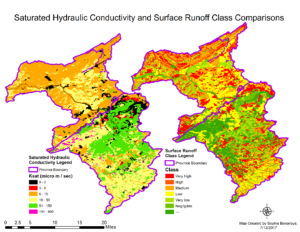
Figure 3: Saturated Hydraulic Conductivity versus Surface Runoff Class Comparisons
Then I looked at saturated hydraulic conductivity and impervious surface percentage comparisons.
Figure 4 below compares the relationship between saturated hydraulic conductivity and impervious surface percentage. As impervious surface increases, high rates of conductivity (6-15 and 51-150 micro meters/sec) decrease in frequency.
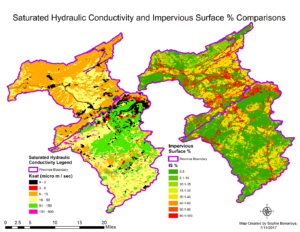
Figure 4: Saturated Hydraulic Conductivity and Impervious Surface % Comparisons
Finally I looked at the breakdown of impervious surface percentage in natural, hydric and urban soils. Figure 5 below shows that over 98% of both hydric and natural soils have 0-5% impervious surface, compared with only 13.51% of urban soils.
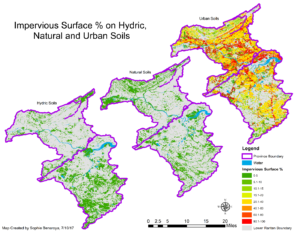
Figure 5: Impervious Surface % on Hydric, Natural and Urban Soils
Through my research I found that unfavorable levels of indicators were linked to lower levels of infiltration. The most interesting finding was the effect of land use on soil health. Urban land had lower infiltration rates than forests, wetlands and agricultural areas. In addition, urban lands had low levels of organic matter, high levels of soil fragments and, high levels of impervious surface. The increase in impervious surface is linked to urbanization. Natural and hydric soils in the Lower Raritan Watershed had less than 5% of their soils exhibit impervious surface cover of 5% or more, compared to almost 75% of urban soils. However, not all urban land uses had the same levels. Athletic fields, recreational land and cemeteries had higher levels of infiltration than military or industrial land; possible because they have more vegetation.
Another important finding had to do with forests. Forests and wetlands have high infiltration rates, however in the Piedmont province there is more fragmentation and as such those forests and wetlands typically have lower levels of infiltration than forests and wetlands in the Coastal Plains province. This means that an increase in the fragmentation of forests potentially due to urbanization would be detrimental to soil health, as forests in the Piedmont have an average saturated hydraulic conductivity rate of 18.52, whilst forests in the Coastal Plains province have an average of 53.21.
The main take-aways from my research is that protection of forested areas could help prevent soils from worsening, and an increase in planting in and around current forest areas could help improve the soil of current patches. An increase in green infrastructure could also be beneficial in improving urban soils by increasing the vegetative cover, organic matter and reducing surface runoff.
Article and photos by Joe Sapia
Note: The yard references are to my house in the section of Monroe between Helmetta and Jamesburg in South Middlesex County. My yard is in a Pine Barrens outlier on the Inner Coastal Plain, the soil is loamy, and my neighborhood is on the boundary of Gardening Zones 6b (cooler) and 7a (warmer). Notes and photographs are for the period covered, unless otherwise noted.
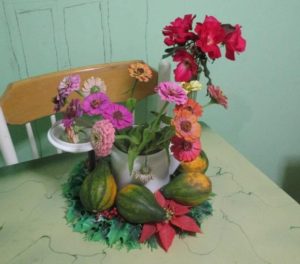
My kitchen table display gets better and better: Gourds, which mysteriously appeared in the garden, are added to the display of zinnias and Knock Out roses on the antique porcelain-top table.
BIG SKY COUNTRY, EMLEY’S HILL: I was driving through one of my favorite places in the Midlands, rural Western Monmouth County. I stopped at Upper Freehold’s Emley’s Hill, part of the cuesta geological formation that divides the Outer and Inner Coastal Plains. Generally, east of this hilly formation drains directly to the Atlantic Ocean, while west of the cuesta drains to the Raritan River. Emley Hill, though, is on a spur of the cuesta dividing the drainages of the Raritan River and the Delaware River. Because it is a hilly rural area at about 140 feet above sea level with lower surrounding farmland, there are beautiful big-sky views. Emley’s Hill is at the intersection of Emley’s Hill Road and Burlington Path Road.
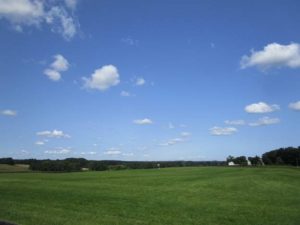
Looking east from Emley’s Hill in Upper Freehold, Monmouth County.
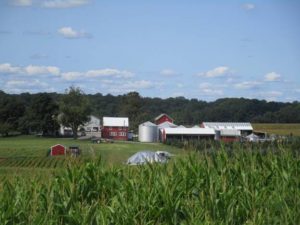
Looking north from Emley’s Hill at the Bullock Farms, http://www.bullockfarms.com/.
WILD OUTDOOR EXPO: The New Jersey Wild Outdoor Expo is an annual event, held at the Colliers Mills Wildlife Management Area in Ocean County. It includes information on environmental issues and parks, hunting, fishing, trapping, other recreational use of the outdoors, and so on.
This year’s expo, held on Saturday and Sunday, September 9 and 10, was sponsored by the state Department of Environmental Protection’s Division of Fish and Wildlife, Division of Parks and Forestry, and Forestry Services, along with the Conserve Wildlife Foundation of New Jersey.
Colliers Mills WMA is the almost 13,000 acres of open space — Pine Barrens forest, fields, waterways, and bodies of water — behind the Six Flags/Great Adventure amusement area. Outside of New Jersey, WMAs are referred to as “game lands.” In New Jersey, WMAs are shared by hunters and other recreational outdoors people.
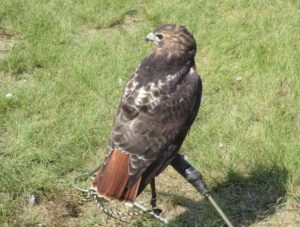
Red-tailed hawk, “Buteo jamaicensis,” on display at the Expo. Note the reddish tail giving the hawk its name. Red tails are commonly seen, soaring above, or commonly heard, calling in a wheezy-sound way.
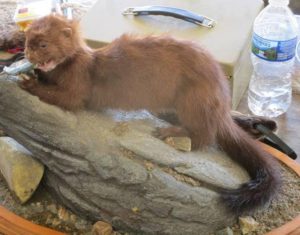
A mounted mink, “Mustela vison.” They are around, but the only two I have seen were both roadkills in recent years in the Pine Barrens around Helmetta.
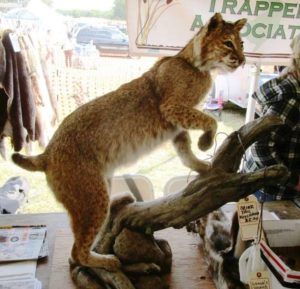
A mounted bobcat, “Lynx rufus.” I describe them as having a dog-like body with a cat’s head. I would love to see one in the wild. The state lists the bobcat as “endangered,” or in immediate peril of surviving.
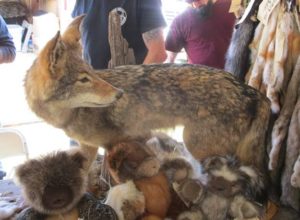
A mounted coyote, “Canis latrans.” Note the dog-like body, but pointy fox-like nose and ears. From 2014 to 2016, I worked an overnight shift near the Metropark train station in Woodbridge, Middlesex County, and I would occasionally see a coyote. One night, an ambulance was on the other side of the woods, yipping its siren. The coyotes started up, yipping away. Smart animals – I once read a suggestion if coyotes had opposing toes, they probably would run the world.
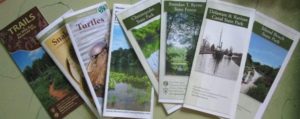
Brochures from the Expo.
FALLING ACORNS: I was driving one of the paved roads through the Jamesburg Park Conservation Area in the Pine Barrens around Helmetta and came across outdoorsman Art Utter, who lives nearby in Spotswood. Art was gathering acorns to use as hunting bait around his deerstand. While we were talking, I was listening to and dodging falling acorns. Earlier, Art got conked on the head by one and it drew blood. These things looked massive. Some might say these acorns suggest a severe winter ahead, with the acorns providing animals with food. I do not think it is a good predictor of anything. The only thing I got out of it was that it seemed as though acorns were falling steadily and they were big.
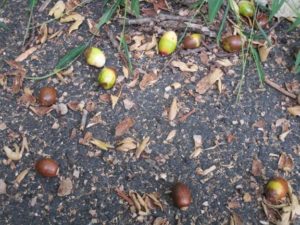
Acorns litter a road in the Jamesburg Park Conservation Area in the Pine Barrens around Helmetta.
IN THE GARDEN: I got tired of looking at the tangle of cucumber and cantaloupe plants that did not produce one usable item this year. So, I mowed them down, along with the tomatillos and gourds, both of which I did not plant. So, now, I look forward to fall lettuce, which is growing nicely, and carrots.
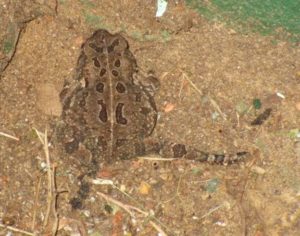
I came across this toad, genus “Anaxyrus,” while cutting the lawn.
THE FLOWERING YARD: The zinnias and Knock Out roses continue to bloom, although the zinnias may have slowed down – perhaps because of powdery mildew and leaf spot. But the Knock Outs seem to be flourishing.
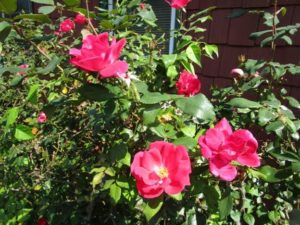
Knock Out roses continue to bloom nicely – even flourishing.
OUT-OF-SEASON FLOWERING: Occasionally, plants bloom out of season. In the past, I remember seeing sheep laurel, “Kalmia angustifolia,” blooming in the fall in the Pine Barrens around Helmetta, when its normal bloom is May and June. Maybe an out-of-season bloom was caused by temperatures and sunlight replicating normal bloom times. Whatever the reason, the flowering quince bush in my yard was actually flowering. Normal flowering would be in the spring.
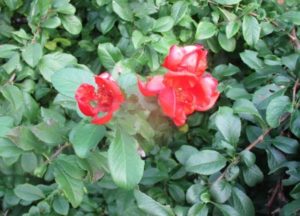
Flowering quince blooming out of season.
BIZARRE EXPERIENCE IN THE YARD: The flowering quince was unusual, but not bizarre. The bizarre experience happened a day earlier, when I was cutting the front yard grass. First, I notice a rabbit, “Sylvilagus floridanus,” watching me from a few feet away on the other side of the hedges. As I have mentioned, if I go about my own business, the rabbits and butterflies allow me to get close. As I was cutting the grass along the street’s edge, I noticed something embedded in the ground where I had just mowed – a 20-gauge, loaded shotgun shell! If I cut that open when I was mowing, I could have sprayed hundreds of pellets. Fortunately, it was intact, but bent, probably having been run over by a vehicle. In the old days, I could have asked any of a number of hunters in the neighborhood what to do. But hunting is becoming less popular, so less available sources. Although it was probably remote I could set off the primer and powder, I did not want to take a chance. So, I called Monroe Police and gave it to responding Officer Bob Bennett with whom I had a great conversation about the local woods. (Officer Bennett opened the conversation, asking if I was the guy…. Uh, oh, a police officer asking if I was the guy! Actually, he asked if I was the guy who posts nature photographs on the local Facebook page. Guilty, Officer. I mean, Yes, Officer.) As for the shotgun shell, who knows where it came from. My friend, the rabbit, disappeared. Was it warning me about the shell?
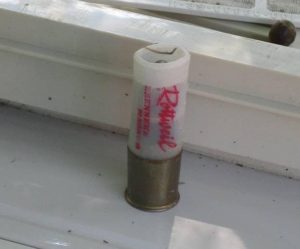
The shotgun shell.
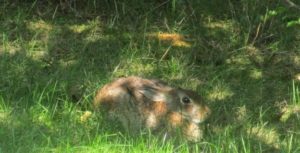
My rabbit friend. Was it warning me about the shotgun shell?
FLOWERING HIGHTSTOWN: One of my regular stops is the Hightstown Diner, where Kathy and George Antonellos have been great hosts over the decades in their 1941 diner. What I notice when I visit the diner is the flowers in this quaint, historic Mercer County town. So, I walked about, shooting photos of them. (If you like South Jersey-Philadelphia scrapple, the Hightstown Diner has it – one of the northernmost locations where scrapple can be found. Me, I love scrapple!)
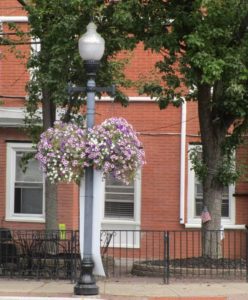
The corner of Mercer Street (Route 33) and Rogers Avenue in Hightstown, Mercer County.
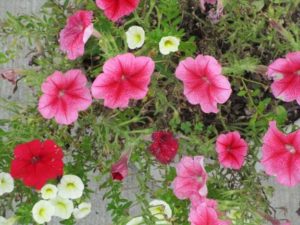
Along Mercer Street (Route 33) in Hightstown, Mercer County.
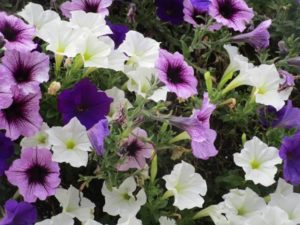
Flowering Hightstown.
DRIVE-BY NATURALIST, A GREAT EGRET: As I was driving home from Hightstown, I crossed the Millstone River, the boundary of East Windsor, Mercer County, and Cranbury, Middlesex County. There, I noticed a perched great egret, “Ardea alba.” Keep an eye out for nature. It is all around us.
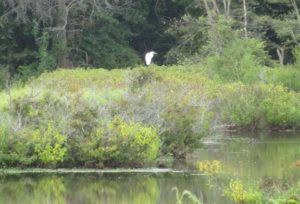
A great egret on the Millstone River. Here, the river is the boundary of East Windsor, Mercer County, and Cranbury, Middlesex County.
OCEAN TEMPERATURES: Atlantic Ocean temperatures on the New Jersey coast were about 72 degrees Friday, September 15.
SUNRISE/SUNSET: For September 17, Sunday, to September 23, Saturday, the sun will rise about 6:40 to 6:45 and set about 6:55 to 7:05. The fall equinox of nearly equal daylight and sunlight is September 22, Friday. For September 24, Sunday, to September 30, Saturday, the sun will rise about 6:50 a.m. and set about 6:45 p.m.
THE NIGHT SKY: The new moon is September 20, Wednesday. The next full moon is the Full Harvest Moon October 5, Thursday.
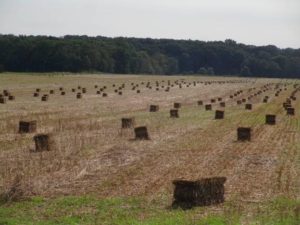
Harvest time it is. Here, hay being harvested on a farm in Cranbury, Middlesex County.
WEATHER: The National Weather Service forecasting station for the area is at http://www.weather.gov/phi/.
Joe Sapia, 60, is a lifelong Monroe resident. He is a Pine Barrens naturalist and an organic vegetable-fruit gardener. He gardens the same backyard plot as did his Italian-American father, Joe Sr., and his Polish-immigrant, maternal grandmother, Annie Poznanski Onda. Both are inspirations for his food gardening. Joe is active with the Rutgers University Master Gardeners/Middlesex County program. He draws inspiration on the Pine Barrens around Helmetta from his mother, Sophie Onda Sapia, who lived her whole life in these Pines, and his Grandma Annie. Joe’s work also is at @JosephSapia on Twitter.com, along with Facebook.com on the Jersey Midlands page.
Article and photos by Joe Sapia
Note: The yard references are to my house in the section of Monroe between Helmetta and Jamesburg in South Middlesex County. My yard is in a Pine Barrens outlier on the Inner Coastal Plain, the soil is loamy, and my neighborhood is on the boundary of Gardening Zones 6b (cooler) and 7a (warmer). Notes and photographs are for the period covered, unless otherwise noted.
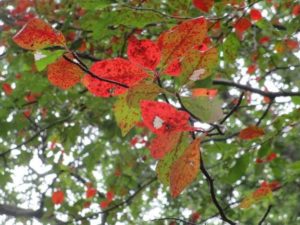 A black gum, “Nyssa sylvattica,” changes color at Cranberry Bog in the Pine Barrens around Helmetta.
A black gum, “Nyssa sylvattica,” changes color at Cranberry Bog in the Pine Barrens around Helmetta.
CHANGING COLORS IN THE PINE BARRENS AROUND HELMETTA: Black gum trees, ““Nyssa sylvattica,” are obvious with their leaves changing colors for the season. “Fall foliage,” meaning the changing colors as colder weather approaches, is a misnomer, because, here, in the Pine Barrens around Helmetta, changing colors are noticeable beginning about July 15 to 31. I look for the peak of the coloring October 13 in wet areas and October 20 in dry areas, but, really, it is impossible to pinpoint a peak. If there is even a peak, because there may not be a uniform turning of colors.
“OPIENKI” MUSHROOMS, PINE BARRENS AROUND HELMETTA: As I drove a paved road through Jamesburg Park today, I saw a car parked at the woods and a woman at the car. She wore yoga pants, a short-sleeve pullover shirt, and sneakers, pants untucked — not really dressed as a woodswoman. So, I took a guess at what she was doing.
Mushrooms? I asked.
She said yes.
What kind, honey mushrooms?, I said.
The woman — Lana, who lived a few miles away from the site — said she did not know the name to tell me. Then, I noticed what sounded to be an Eastern European accent.
“Opienki”? I asked.
Yes, she smiled. How did you know that name?
A grandmother from Poland, I said.
Lana is from the Ukraine. She was picking edible mushrooms of the genus “Armillaria,” known by Polish people as “opienka” singular and “opienki” plural. “Pien” means stump in Polish and these mushrooms grow along the stumps of dead oaks. Hence, they also are known as “stumpies” — and “tan and yellow stumpies” because of their color and, of course, where they are found. But the general public probably would know them best by their common name, “honey mushrooms.”
Lana had bags filled with mushrooms in her car. (See the photos, which she let me take.)
Journalisticly, I am publishing this to inform people. In a neighborly way, I am hesitant to publish this because PICK THE WRONG MUSHROOM AND, AT BEST, YOU WILL GET SICK, AND, AT WORST, YOU WILL DIE.
I am 60-years-old and have been in these woods my whole life, and have heard stories from them going back another 50 or 60 years to when my maternal family settled here, and I will confidently pick ONLY ONE mushroom in the Pine Barrens around Helmetta: opienka. In the Jersey Midlands as a whole, I will confidently pick ONLY TWO: the second one, a morel, which I am familiar with on the Piedmont — say, at such areas as Princeton and Sourland Mountain.
I am “somewhat confident” to pick two more. But I made it to 60 and “somewhat confident” does not cut it. Remember the adage: There are bold mushroom pickers and there are old mushroom pickers. There are no old AND bold mushroom pickers.
If one must pick mushrooms, three bits of advice, even for the experienced picker: One, know how to call emergency responders, telephone 911; two, the telephone number of New Jersey Poison Control, 800-222-1222; and three, save one mushroom, perhaps on your kitchen counter, so doctors know the mushroom one ate.
I said good-bye to Lana, warning her of ticks, which can pass along disease such as Lyme, and chiggers, which will get one itching, beginning about 36 hours after leaving the woods, and scratching like crazy for days. (Me, man who got chiggers a week ago, here, in the Pine Barrens around Helmetta. Me, stupid man because I was not thinking and did not avoid grassy areas.)
(Dedicated to Grandma Annie Poznanski Onda, born 1885 in Poland, died 1972 in the Pine Barrens around Helmetta. And a big thank you to Ralph “Rusty” Richards, woodsman extraordinaire of the Pine Barrens around Helmetta, who continues to be a local woods mentor to me.)
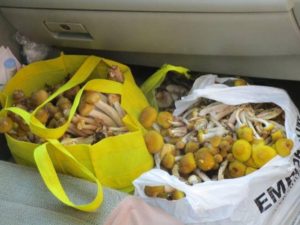
Lana’s “opienki” mushrooms in the Pine Barrens around Helmetta.
ALSO IN THE PINE BARRENS AROUND HELMETTA: Look for fall bloomers, such as asters. Joe Pye weed, “Eutrochium purpureum,” remains blooming – and will do so until about October. Queen Anne’s lace, “Daucus carota,” continues blooming to about November. The seed heads of punks, or cat-tails, genus “Typha,” were fluffing as summer passes.
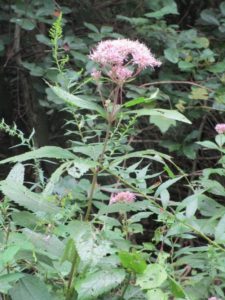
Joe Pye weed in bloom near the Ditch in the Pine Barrens around Helmetta.
CHIGGERS IN THE PINE BARRENS AROUND HELMETTA: I did a brief hike Friday, Sept. 1, and began itching around Sunday morning – chigger bites! Fortunately, I did not get a bad case, a bit of itching here and there on my legs. I first encountered chiggers, here, in about 2004. Some view chiggers as a Southern species moving north; Others will say we already had them up here. I knew of chiggers from hiking in the Pine Barrens down in South Jersey. The bottom line is they itch! So, I will scratch for a few days, then life will go on until the next round of chiggers. (A tip: Avoid grassy areas such as those I walked in on my hike. I just was not thinking.)
MA, GRANDPA, AND THE LOCAL PINE BARRENS: Perhaps I was not thinking of chiggers on Sept. 1 because my mind was elsewhere. Earlier that day, I had mailed in a donation to my church, Holy Trinity Roman Catholic Church in Helmetta, and a request for a Mass to be said in Grandpa Mike Onda’s honor October 11– the 100th anniversary of his death in Helmetta from tuberculosis at 35–years-old. He left a 32-year-old widow, Annie Poznanski Onda, and three children 5-years-old and younger. One of those children was my mother, Sophie Onda Sapia, who was 3 when her father died. Her only memory of her father in later years was of her with him at Shekiro’s Pond in Helmetta. September 1 was the 22nd anniversary of Ma’s death at 81 in 1995. On this anniversary, I visited Shekiro’s Pond.
PESTS IN THE YARD: Neighbor Tom DeRose contacted me on the night of Labor Day, wanting to show me something in his yard. So, in the dark with flashlights, Tom and I were looking into a hole – perhaps big enough to shove in a few golf balls – of yellow jacket wasps. Ugh! They have scared me since I was a kid playing Army in this same neighborhood with Eddie Kasubinski. I pointed down the street at “The Swamp,” where Eddie and I got attacked – not by an opposing army, but by “yellow jacks.” I ran up the street crying. My father heard me, rushed into the backyard, saw the yellow jacks attacking me, grabbed my Army jacket, which had yellow jacks in it, and threw it aside. A number flew out of the jacket. I had got stung twice. Yellow jacks can be aggressive and multiple stingers. So, I advised Tom to stay away from his side yard until the cold weather sets in or spray a pesticide into the hole.
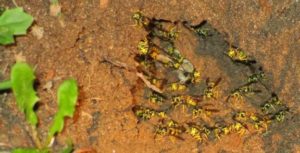
The yellow jacket nest in Tom DeRose and Trisha Miller DeRose’s side yard.
LAURINO FARMS: I was out in Monmouth County and stopped by Laurino Farms on Route 537 (between Laird and Swimming River Roads) in Colts Neck. There, I picked up a favorite of mine, white peaches, along with a jar of cranberry preserves. A shout out to Bobby Laurino, whom I saw briefly – personally, Bobby has patiently answered my gardening questions and he is an inspiration for me growing zinnias this year. And, more importantly, a shout out to Bobby for what he does for feeding the needy, including helping the Soul Kitchen restaurants (www.jbjsoulkitchen.org) in Red Bank and Toms River, founded by rock and roll star Jon Bon Jovi and his wife, Dorothea Bongiovi, who live in Middletown, Monmouth County, to support the needy. For example, Laurino provides space at his farm for Soul Kitchen to grow food organically. Dorothea said, “Bobby is an amazingly generous person, not only with his contribution of land to the Soul Kitchen so we could raise our own vegetables, (but) he is generous with his time, his knowledge, his spirit. I am not sure if all farmers are as optimistic as Bobby, but he has a positive can-do attitude that maybe all farmers need. Farming is an unbelievably difficult life, with many uncontrollable variables: temperature, rain, sun, insects (Bobby does not use pesticides), animals. I have enormous respect for anyone who grows food for others.” (And a shout out to Dorothea, who handles herself with class and humility. Over the summer, Dorothea received a Volunteer Leadership Award in the New Jersey State Governor’s Jefferson Awards for Public Service for her work with Soul Kitchen. “I was very surprised and humbled by the Jefferson award,” Dorothea said.)
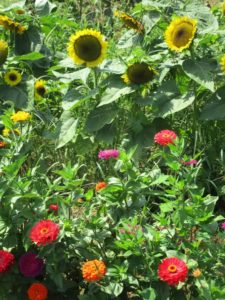
Zinnias and sunflowers at Laurino Farms in Colts Neck, Monmouth County.
DRIVE-BY NATURALIST, “BIDENS” FLOWERS: Although I know the yellow flowers of the genus “Bidens” are adorning unplowed farmland and disturbed areas, it still amazes me when I come across fields of these flowers. I was driving in southern Monroe and came across this batch, next to acres of soybeans.
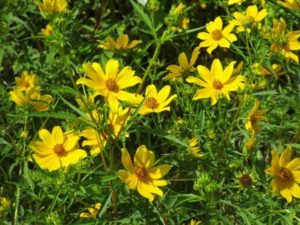
Yellow flowers of the genus “Bidens” in southern Monroe.
IN THE YARD AND GARDEN: The zinnias and Knock Out roses continue to bloom earnestly.
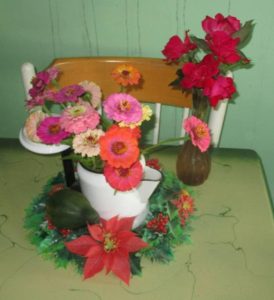
Zinnias, Knock Out roses, and a gourd, all from the my yard or garden, decorate the antique porcelain-top table in my kitchen. One of Ma’s old coffeepots is used as a vase.
MY BELOVED ZINNIAS: While still flowering wonderfully, the zinnias appear to have contracted powdery mildew. So, I will be dealing with this.
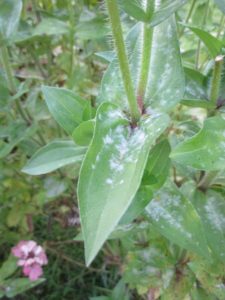
Apparently powdery mildew on the zinnias.
IN THE GARDEN: My summer crop, except for the zinnias, was a disaster. The sweet corn was undeveloped, probably because of too much rain and I should have planted in a bigger block to foster pollination, but it was harvestable and tasty. Too much rain translated into no cucumbers, no cantaloupe. Very few tomatoes, because something ate the tops off the plants.
MECHKOWSKI FARM: Timmy Mechkowski farms in Helmetta. He reported good crops of sweet corn, beets, stringbeans, carrots, broccoli, cabbage, and onions. “Tomatoes were decent until the end, when we starting getting the rain.” Timmy reported a bad year for peppers, potatoes, and blackberries. The Mechkowski farm is one of my favorite places.

Sitting on the front porch of his house, Timmy Mechkowski goes over his planting list.

Timmy Mechkowski’s dog, Abby, probably the most beautiful and most gentle dog I have ever met.
NAVESINK RIVER: The Navesink River drains about 95 square miles in the Red Bank area of Monmouth County. It abuts the hilly geological formation that separates the Inner and Outer Coastal Plains. The river sits on the Outer Coastal Plain side. These photos were taken downstream of the Ocean Bridge from the Middletown side. The bridge connects Middletown and Rumson. The Navesink River is one of my favorite places in the Jersey Midlands.
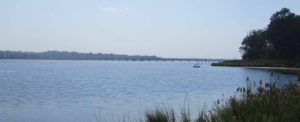
On the Navesink River, looking toward the Oceanic Bridge connecting Rumson, left, and Middletown, right.
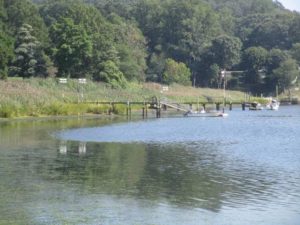
Along the Navesink River.
DRIVE-BY NATURALIST, GREAT BLUE HERON: As I was leaving the Navesink River, I noticed a great blue heron, “Ardea Herodias” – a large bird I am in awe of.
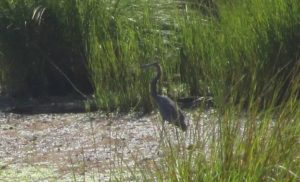
The great blue heron along the Navesink River.
BIG SKY COUNTRY, MONROE TOWNSHIP: As the Jersey Midlands continue to develop, there is more a loss of big sky views. But the area between the Applegarth and Wyckoff’s Mills sections of Monroe is still a holdout. Here, there are wonderful views over soy bean fields and cornfields.
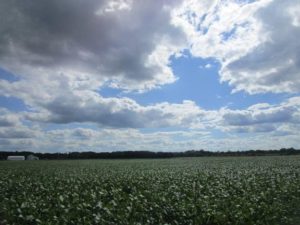
Between Monroe’s Applegarth and Wyckoff’s Mills sections, looking over a soybean field toward Route 33.

Between Monroe’s Applegarth and Wyckoff’s Mills sections, looking toward Cranbury, with corn growing to the right and soybeans to the left.
THE FLIP SIDE OF BAMBI: I have published photographs of beautiful deer in nature. I need to point out the flip side: deer on farmland and in garden. Years ago, I was talking to a farmer who grew corn on the state’s Assunpink Wildlife Management Area in western Monmouth County. The farmer paid no rent, but he had to leave a percentage of his crop to feed wildlife. The way I recall the story: “The problem is,” the farmer said, “the deer don’t know which 75 percent is mine and which 25 percent is theirs.” As Jersey Midlands nature writer John McPhee has written, “Deer, in my opinion, are rats with antlers, roaches with split hooves, denizens of the dark primeval suburbs. Deer intensely suggest New Jersey.”
OCEAN TEMPERATURES: Atlantic Ocean temperatures on the New Jersey coast were in the range of about 69 to 72 degrees during the weekend of September 9-10.
SUNRISE/SUNSET: For September 10, Sunday, to September 16, Saturday, the sun will rise about 6:35 to 6:40 a.m. and set about 7:10. For September 17, Sunday, to September 23, Saturday, the sun will rise about 6:40 to 6:45 and set about 6:55 to 7:05. The fall equinox of nearly equal daylight and sunlight is September 22, Friday.
THE NIGHT SKY: This week, in the pre-sunrise sky, I saw the constellation Orion for the first time this season – Colder weather is coming with the winter constellations. The moon is waning after the September 6 full moon. The new moon is September 20, Wednesday. The next full moon is the Full Harvest Moon October 5, Thursday.
WEATHER: The National Weather Service forecasting station for the area is at http://www.weather.gov/phi/.
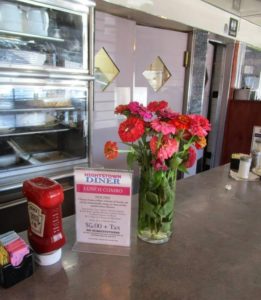
Joey’s zinnias at the Hightstown Diner, in Hightstown, Mercer County.
Joe Sapia, 60, is a lifelong Monroe resident. He is a Pine Barrens naturalist and an organic vegetable-fruit gardener. He gardens the same backyard plot as did his Italian-American father, Joe Sr., and his Polish-immigrant, maternal grandmother, Annie Poznanski Onda. Both are inspirations for his food gardening. Joe is active with the Rutgers University Master Gardeners/Middlesex County program. He draws inspiration on the Pine Barrens around Helmetta from his mother, Sophie Onda Sapia, who lived her whole life in these Pines, and his Grandma Annie. Joe’s work also is at @JosephSapia on Twitter.com, along with Facebook.com on the Jersey Midlands page.
Article and photos by Joe Mish
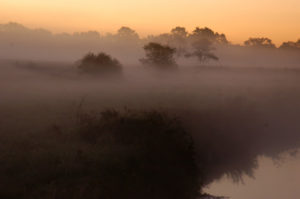 An orange sky rests upon the impenetrable white fog as dawn breaks over Holland brook on the first day of September. The predawn landscape is shrouded in a heavy mist so deep, only the treetops can be seen.
An orange sky rests upon the impenetrable white fog as dawn breaks over Holland brook on the first day of September. The predawn landscape is shrouded in a heavy mist so deep, only the treetops can be seen.
As September exhales the last warm breath of summer, it begins to inhale cool autumn air in a respiratory sequence of endless seasonal change.
With barely 9 days of autumn out of 30, the title to September is in summer’s name, despite the lien filed by fall for possession. The struggle that ensues is openly expressed in fits of alternate ownership, where autumn takes over with chilly nights while summer responds with beautiful warm days, indistinguishable from its July and August menu.
The engagement of warm summer days and cool autumn nights, in a battle for dominance, leaves the river’s flood plain covered with heavy morning mist. The impenetrable white fog hides everything except isolated tree tops to give the impression of a primordial soup that first gave rise to life on earth.
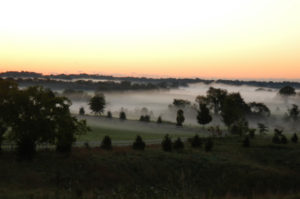
White mist rising up from the South Branch, submerges trees in a dense early morning fog, characteristic of the drastic day and night temperature changes in early fall.
As autumn appeals its case to the heavens, the sun begins to shift its position and rides lower in the sky, away from its high summer orbit. Evidence of this collusion is signaled as the dawn light colors the morning mist with every tint from gold thru orange to deep purple; a precursor to the colorful foliage that defines the fall season. The colors signal another vote for autumn’s plan to own September.
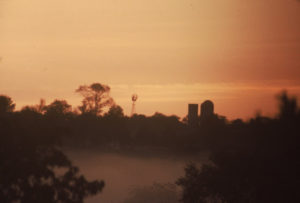
Except for the silhouette of farm building on the high ground, this scene has played out along the South Branch for thousands of years when autumn approaches.
Ultimately it is the stars in the heavens which have the final say, as they align to signal the exact moment of the autumnal equinox to find in fall’s favor. There is no chance of appeal, though summer still resists.
Offering blue skies and warm days, scraped from the bottom of it’s now empty quiver, summer attempts to keep the foliage from changing to a colorful no vote.
First to buy into autumn’s argument is Virginia creeper and poison ivy. Summer ignores their decision and counters that vines showed color back in August. A time clearly owned by summer and validated by consensus. It is when the black gum trees’ leaves began to turn a bright salmon color that summer’s brave stance began to waver. Here was a tree whose leaves began to light up the greenery like old fashioned lights tacked to the porch rail to celebrate the holiday season. Once the trees began to turn, summer knew its days were numbered.
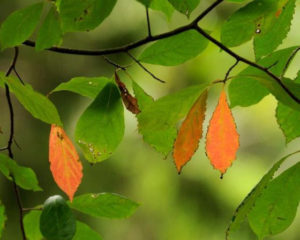
Black gum leaves mark the beginning of nature’s display of autumn color.
The stalwart oaks were the next to be counted as they sounded in favor of autumn, treating each fallen acorn as a separate vote. The deer found in favor of summer and began to eat all the fallen acorns in an attempt to cancel the oaks’ ballots. If summer was hard of hearing and the polling place rife with fraud, the oaks along with the sweet gum trees blinded the hillsides with color. Deep scarlet red oak leaves combined with a brilliant array of yellow, purple and old rose, star shaped sweet gum leaves. Norway and sugar maples chimed in with fluorescent red and yellow leaves. The final tally was overwhelming, a landslide in favor of autumn’s claim to September and an end to summer’s futile efforts to hang on.
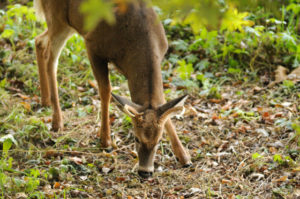
A young buck searches the ground for acorns in early September. Acorns are the number one food that deer love. when you see deer hanging around under a tree in early fall, notice that tree is more than likely an oak. Deer dine as we are supposed to, they eat what is in season.
Summer looked upon the flowers of the field to see the drooping heads and faded colors of the delicate muses it so carefully nurtured and who, in return, stood by summer’s side until their death. Summer was finally moved to surrender its claim of September to autumn. With a last warm breath, summer whispered a vow to return, even before the final days of the next spring.
Author Joe Mish has been running wild in New Jersey since childhood when he found ways to escape his mother’s watchful eyes. He continues to trek the swamps, rivers and thickets seeking to share, with the residents and visitors, all of the state’s natural beauty hidden within full view. To read more of his writing and view more of his gorgeous photographs visit Winter Bear Rising, his wordpress blog. Joe’s series “Nature on the Raritan, Hidden in Plain View” runs monthly as part of the LRWP “Voices of the Watershed” series. Writing and photos used with permission from the author.
Article and drawing by Maya Fenyk, age 13
Hello! I am Lynx Rufus, but you can call me Blossom the Bobcat. I am New Jersey’s only native wildcat, and have been on New Jersey’s endangered species list since 1991. Sightings of me in the Lower Raritan Watershed and throughout the state are increasing, but are still rare.
You might think “Oh, bobcats must survive just fine. They are at the top of the food chain. They have no predators.” I am sorry to say, that’s just not true. Some of my predators are mountain lions, coyotes, foxes, owls, wolves and humans. I can’t say I blame them as I also prefer a carnivorous diet. My prey includes rabbits, rats, squirrels, ground-nesting birds, turkeys and even small or sick deer. But predator threats are not my biggest concern.
My species used to be abundant and flourishing in the coniferous and mixed forests of New Jersey until humans started deforesting our homes. Clearing land for retail, corporate and housing developments has a huge impact on my survival. And disruption of our habitat by pipelines has huge impacts on us and other endangered, threatened and special concern species. Other issues that affect me are hunting and being hit by cars. Getting hit by cars, development and pipeline installation are linked. Fragmentation of my habitat makes it hard for me to find shelter from the weather, cover for hunting and raising my babies, and forces me and my family to cross roads to find our dinner and safe spaces to hide. Please slow down through forested areas! When humans ruin my home, push me onto their roads, and drive too fast through the woods it really gets my angry purring going.
The New Jersey Department of Environmental Protection’s Endangered and Nongame Species Program’s Bobcat Recovery and The Nature Conservancy’s Bobcat Alley are both doing a great job restoring bobcats in New Jersey, but plans for pipelines and proposals to reduce protections under the state’s Freshwater Wetlands Protection Act and the federal Clean Water Act put our population recovery into question.
I must head to my den to check on my kittens, but I want to let you humans know how important it is to keep track of the numbers of my species. To report a bobcat or other endangered species sighting, please contact NJDEP. Thanks! And I say that with a final meow!
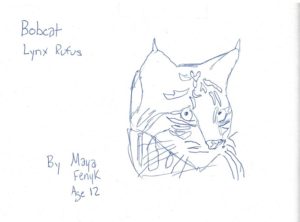
NJDEP Announces Response Strategy for Harmful Freshwater Algal Blooms, Seeks Public’s Help to Identify Suspected Incidences
Statewide Effort to “Avoid It and Report It” Includes Online Form for Reporting Suspected Blooms
Seeking to minimize health risks for people and animals, the Department of Environmental Protection (DEP) has developed a strategy for a unified statewide approach in responding to incidents of Harmful Algal Blooms (HABs) in freshwater bodies across the state.
Under the new “Avoid It and Report It” effort, anyone who sees a suspected bloom resulting from cyanobacteria may contact DEP through its toll-free hotline or the WARN NJDEP app for smartphones and tablets. In addition, a new website ( http://www.state.nj.us/dep/wms/HABS.html) has been launched to coordinate important information and response activities. Alerting DEP to the suspected blooms quickly can help protect public and animal health and freshwater resources.
“Expanding our ability to respond to Harmful Algal Blooms, establishing preparedness procedures, and making information about these blooms more readily available to the public enables DEP and its partners to better protect the health of those who use New Jersey’s lakes and streams for recreation,” said Dan Kennedy, Assistant Commissioner for Water Resources Management.
Most algal blooms observed in New Jersey’s waterways are harmless and are not cyanobacteria. They result from too many nutrients causing excessive blooms of naturally present algae.
Cyanobacteria, also known as blue-green algae are usually a bright green, but can also appear as spilled paint, “pea soup,” or as having a thick coating or “mat” on the surface. They can often be confused for typical algae blooms. Cyanobacteria are also naturally present in lakes and streams in low numbers. Under suitable environmental conditions – sunlight, high nutrients, warm temperatures and calm water – dense cyanobacterial blooms can form. Cyanobacterial blooms do not always produce toxins, but when they do the blooms can pose a risk to people, pets, livestock and wildlife if exposure occurs by ingestion, inhalation of contaminated water, or dermal contact. Rashes can occur when cyanobacteria cells come in contact with skin.
When a suspicious bloom is observed, people are advised to Avoid It and Report It by following these steps:
. Avoid contact with water in the vicinity of the bloom, especially in areas where the bloom is dense and forms scums;
. Do not drink or consume the water;
. Do not eat fish from the waterbody;
. Keep pets and livestock away from the water;
. Do not allow animals to drink the water, eat dried algae, or groom themselves after coming into contact with the water;
. People, pets and livestock that come into contact with a bloom should rinse off with fresh water as soon as possible;
. Seek medical attention or a veterinarian if a person or animal is experiencing adverse health effects after exposure to a bloom; and
. Report a suspected HAB by calling the DEP Hotline at 1-877-WARNDEP (927-6337) or send a mobile alert through the WARN NJDEP mobile app (available via iTunes, Google Play or Windows Phone).
The new response strategy, developed jointly by the DEP and the state Department of Health (DOH), with technical input from the state Department of Agriculture, protects the public from risks associated with exposure to cyanobacteria and related toxins.
While the primary focus of the strategy is protection of human health, it also provides information on how to prevent exposure to domestic animals and livestock. The New Jersey Water Monitoring Council and the U.S. Environmental Protection Agency’s Office of Water provided technical input and review of New Jersey’s HABs strategy.
The response strategy covers freshwater lakes, rivers, and streams with potential public access, recreational use, and bathing beaches (including licensed beaches). While these waterbodies may also be sources of drinking water in New Jersey, the focus of the response strategy is recreational use. DEP works closely with drinking water systems to plan for HABs as well as all other drinking water emergencies.
The strategy includes:
. Procedures for reporting suspected cyanobacterial HABs;
. Information regarding which agencies/organizations are responsible for responding to an HAB report and what actions are to be taken;
. New Jersey recreational risk thresholds;
. Acceptable methods for conducting monitoring and analysis;
. Recommended advisory language; and
. A process for developing a HAB research plan.
Based on information from the U.S. Geological Survey, 19 states had public health advisories for cyanobacterial blooms in August 2016. With the release of the new response strategy, New Jersey joins more than 30 other states who have developed HAB strategies and/or HAB public awareness informational materials. So far this summer, New Jersey has responded to nine confirmed or suspected HABs in lakes and streams.
The new NJDEP HAB-focused website, found at http://www.state.nj.us/dep/wms/HABS.html , contains information on both freshwater cyanobacterial HABs, and a variety of marine water HABs. Highlights include an electronic cyanobacterial HAB Reporting Form, downloadable Advisory signs and flyers for use for HAB events, a general cyanobacterial fact sheet, and a more detailed fact sheet on recreational exposure and health effects related to cyanobacterial HABs. General information about cyanobacterial HABs, what to do if people or pets are exposed, links to the EPA and U.S. Centers for Disease Control’s HABs websites and other resources, as well as a gallery of both HAB and non-HAB photos of lakes and streams, are also provided.
For questions regarding the freshwater harmful algal bloom strategy, call DEP’s Bureau of Freshwater and Biological Monitoring at (609) 292-0427 or email mailto:njcyanohabs@dep.nj.gov
To learn more about the NJ Water Monitoring Council, visit http://www.nj.gov/dep/wms/wmcchome.html
For more about DEP’s Division of Water Monitoring and Standards, visit http://www.nj.gov/dep/wms/
The new NJDEP HAB-focused website, found at http://www.state.nj.us/dep/wms/HABS.html, contains information on both freshwater cyanobacterial HABs, and a variety of marine water HABs. Highlights include an electronic cyanobacterial HAB Reporting Form, downloadable Advisory signs and flyers for use for HAB events, a general cyanobacterial fact sheet, and a more detailed fact sheet on recreational exposure and health effects related to cyanobacterial HABs. General information about cyanobacterial HABs, what to do if people or pets are exposed, links to the EPA and U.S. Centers for Disease Control’s HABs websites and other resources, as well as a gallery of both HAB and non-HAB photos of lakes and streams, are also provided.
Article and photos by Joe Sapia
Note: The yard references are to my house in the section of Monroe between Helmetta and Jamesburg in South Middlesex County. My yard is in a Pine Barrens outlier on the Inner Coastal Plain, the soil is loamy, and my neighborhood is on the boundary of Gardening Zones 6b (cooler) and 7a (warmer). Notes and photographs are for the period covered, unless otherwise noted.
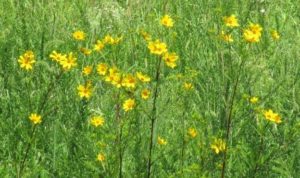
Flowers of the “Bidens” genus growing along South River Road/Route 535 in Cranbury, Middlesex County.
YELLOW FLOWERS IN FIELDS: This time of year, it is common to see a yellow flower of the “Bidens” genus on overgrown farmland. Over the last dozen years, I have seen them begin blooming from about August 20 to August 25. This year, I saw the first blooming August 24, Thursday – in this case in Cranbury, Middlesex County.
IN THE GARDEN, SWEET CORN: I wrapped up the sweet corn harvest, which produced a poor, but usable, crop. The ears developed only partially, basically one half with kernels, one half without. The poor development may be attributable to poor pollination. Corn should be planted in blocks so its pollen can fly back and forth to the plants in the wind. If pollination was the problem, I see two major reasons – one, my corn block was probably too small, in part thanks to a house re-modeling project that fouled up my garden area and by planting a bigger garden this year, I lost area to plant corn in larger blocks and, two, the wet weather may have kept down the spread of pollen. Because I like eating the corn raw off the cob or, if cooked, then sliced off with a knife, the poor development did not affect me in eating what I could harvest. But the quantity of the harvest also was terrible, meaning I had less corn to eat.
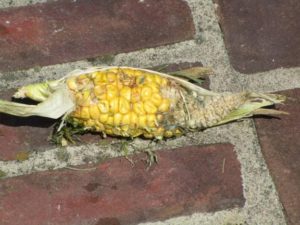
A half-developed ear of corn from the garden.
ELSEWHERE IN THE GARDEN: The early cool-weather harvest was so-so – great pickings of lettuce, carrots having a low yield, and peas bombing out. The jury is still out on the summer crop – I gave up on growing tomato plants from the seeds I planted and bought plants, only to have something eat the tops off of them; as I said, the corn generally bombed; the cucumbers bombed, probably because of too much rain, and I still have hope for mushmelon. My first-time planting of zinnias has saved the summer crop.
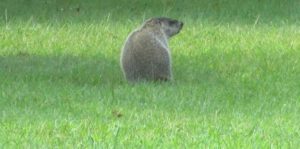
This may be the culprit that is eating the plants in my garden – a ground hog, “Marmota monax.” It was photographed in my next-door neighbor’s yard.
GRATEFUL FOR THE ZINNIAS: If it was not for my zinnias, planted in the food garden to attract pollinators, I would not have much of a summer harvest. Not only do the zinnias attract pollinators, but they are nice to look at – and give away.
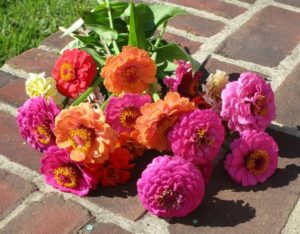
Zinnias as a gift for the eye doctor’s office.
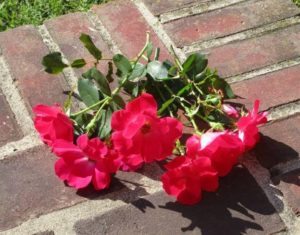
Add some Knock Out roses for the eye doctor’s office.
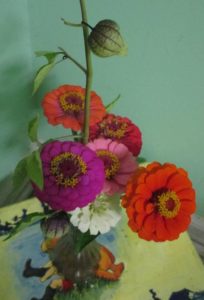
Zinnias, along with tomatillos, for the kitchen table.
ZINNIAS AND BUTTERFLIES: My morning zone-out time, just after getting up, would be watching the birds at the feeder. This summer, however, I gave up the feeder – saving money on top-quality (and costly) feed of corn kernels and putting the birds to work harvesting insects in the yard. So, until cool weather comes and the feeder goes back up, my only meditative exercise was watering the garden. Now, I found something new – watching the butterflies in the zinnia. I have discovered if I just go about my business of walking through the zinnia patch or harvesting zinnia, the butterflies just go about their business. They do not fly off by my intrusion. The butterflies and I have become friends. I am becoming one with the zinnia patch.
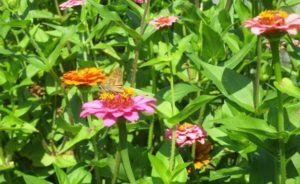
I believe the butterfly on the zinnia is a sachem, “Atalopedes campestris.”
DRAGONFLIES AROUND THE YARD: My yard seems to have hosted a lot of dragonflies this summer. Now, I have to learn to identify them.
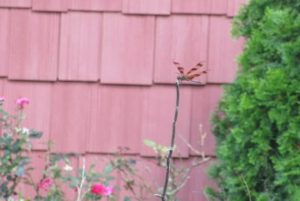
A dragonfly in my backyard.
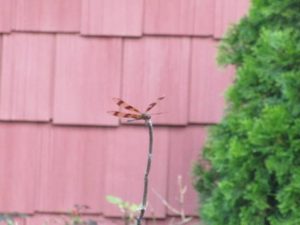
Another view of the dragonfly in my backyard.
KEYPORT HARBOR: On a free-lance writing assignment, I had to go out to the Raritan Bayshore of Monmouth County, so I stopped by Keyport harbor to crank off some photographs.
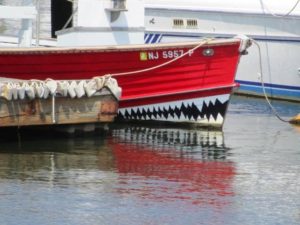 Jaws at Keyport Harbor, Monmouth County
Jaws at Keyport Harbor, Monmouth County

From Keyport harbor, looking to Staten Island, New York City, in the hazy distance.
THE ECLIPSE OF THE SUN: My plan was to stay inside during the August 21, Monday, solar eclipse, so as not to be tempted to look at the sun and possibly ruin my eyesight. Well, I was working at my desk during the eclipse, realized I left my camera in my Jeep, and went outside to retrieve it. I grabbed a kitchen strainer and, with my back to the sun, let the sunlight shine through the holes of the strainer onto my back porch. It was pretty cool, watching dozens of shadows of the sun in eclipse. With about 75 percent of the sun covered around 2:45 p.m., sun shadows were obvious, but the sunlight had the soft glow of dusk. Insects remained calling and a butterfly flew by.

The eclipse through the strainer.
BLUEBIRD SKY: While out in the yard August 24, Thursday, I noticed how clear the sky was – a “bluebird sky.” Jet airplanes could be clearly seen, with that I-almost-can-touch-them look. That means there was little moisture in the air – a dew point of only 52.
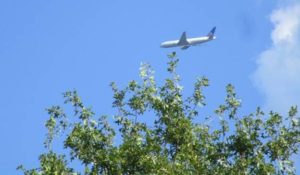
With low moisture in the air, this United Airlines flight, headed to Newark Liberty International Airport from Tel Aviv, Israel, looked very close to my backyard. It was actually flying at an estimated 3,000 feet.
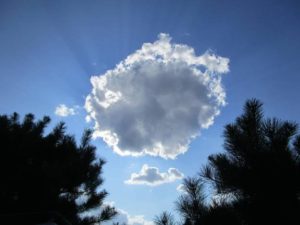
Another view of the “bluebird sky” from my backyard.
DEW POINT: My go-to science guy – Joey Slezak of Helmetta, who has a bachelor’s degree in meteorology and is now working on his master’s in meteorology, both from Rutgers University – tells me dew point, not the humidity reading, is the real gauge of moisture around us and how we feel in it. Here, according to www.fredericksburg.com in Virginia, is how we feel at these dew points — under 55, pleasant; 56 to 60, comfortable; 61 to 65, getting sticky; 66 to 70, uncomfortable; 71 to 75, oppressive; more than 75, miserable.
BOBWHITE QUAIL IN NEW JERSEY: A Philadelphia Inquirer article about restoring BobWhite quail, “Colinus virginianus,” to the Pine Barrens, http://www.philly.com/philly/columnists/kevin_riordan/bringing-back-a-bird-that-once-made-a-signature-sound-of-the-pine-barrens-20170822.html. See Cornell University’s All About Birds website for more on the BobWhite, https://www.allaboutbirds.org/guide/Northern_Bobwhite/id.
CRICKETS IN MY CELLAR: As an only child, I inherited the house I grew up in and which my parents owned for almost four years before I was born in 1956. I never remember crickets in the cellar when I was a kid. But after I took over the house 15 years ago, I noticed a cricket invasion from about August until the fall weather set in. Now, a cricket-chirping cacophony is pleasant, but one or two crickets in the wee hours while one is trying to sleep is AN-NOY-ING – and it turns me from Dr. Naturalist to Mr. Killer, Serial Killer if there is more than one of these little nuisances calling away. But I just had a $38,000 re-modeling of my house, including new siding and insulation. The best $38,000 I could spend on eradicating crickets from the cellar. So far, and it is already late August, only six crickets – none of which are with us anymore. I mean, if a cricket wants to live outside and chirp away, I get it. But if a cricket wants to invade my cellar and rub those little ugly legs together, NO. (OK, OK, OK, now that I feel sort of bad about cricket killing, I will tell you about Revenge of the Crickets. A few years ago, I saw a cricket in the cellar. And I had had it! So, I picked up the pail I used to empty de-humidifier water into and SMASHED the cricket. I poured the de-humidifier water into the bucket — and the water spilled onto the cellar floor. Yes, I had cracked the bucket when I obliterated the cricket. I never learn – whenever I act surly, I pay for it.)
(Sorry, no photo of a dead cricket.)
OCEAN TEMPERATURES: Atlantic Ocean temperatures on the New Jersey coast were in the range of about 74 to 77 degrees.
SUNRISE/SUNSET: For August 27, Sunday, to September 2, Saturday, the sun will rise about 6:20 to 6:25 a.m. and set about 7:30 p.m.
WEATHER: The National Weather Service forecasting station for the area is at http://www.weather.gov/phi/.
UPCOMING: September 9 and 10, Saturday and Sunday, 10 a.m. to 5 p.m., the state Department of Environmental Protection’s Wild Outdoor Expo at the Colliers Mills Wildlife Management Area, Jackson, Ocean County, WildOutdoorExpo.com.
DOES ANYBODY ELSE…?: …Go to a fast-food restaurant and instead of tossing in the garbage all the paper packaging and so on, take it home for recycling?

Sailboats at Keyport harbor.
Joe Sapia, 60, is a lifelong Monroe resident. He is a Pine Barrens naturalist and an organic vegetable-fruit gardener. He gardens the same backyard plot as did his Italian-American father, Joe Sr., and his Polish-immigrant, maternal grandmother, Annie Poznanski Onda. Both are inspirations for his food gardening. Joe is active with the Rutgers University Master Gardeners/Middlesex County program. He draws inspiration on the Pine Barrens around Helmetta from his mother, Sophie Onda Sapia, who lived her whole life in these Pines, and his Grandma Annie. Joe’s work also is at @JosephSapia on Twitter.com, along with Facebook.com on the Jersey Midlands page. Copyright 2017 by Joseph Sapia
Article and photos by Joe Sapia
Note: The yard references are to my house in the section of Monroe between Helmetta and Jamesburg in South Middlesex County. My yard is in a Pine Barrens outlier on the Inner Coastal Plain, the soil is loamy, and my neighborhood is on the boundary of Gardening Zones 6b (cooler) and 7a (warmer). Notes and photographs are for the period covered, unless otherwise noted.
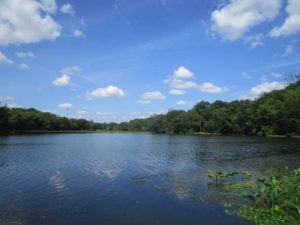
Etra Lake, in East Windsor, Mercer County, sits on the Inner Coastal Plain. Most, if not all, bodies of water on New Jersey’s Inner and Outer Coastal Plains, are human-made – in Etra Lake’s case by the damming of Rocky Brook. Rocky Brook is part of the Raritan River-Bay watershed. The damming of the lake appears to go back to the late 1700s to create a power source to run a grist mill. The name “Etra” actually is an acronym, “ETRA,” after a prominent resident, Edward Taylor Rosel Applegate, born in 1831 and died in 1915.
THE CUESTA: Of New Jersey’s four land regions, two are in the Jersey Midlands – the rolling terrain of the Piedmont and the generally flat Coastal Plain. The Coastal Plain can be broken down further – the Outer and Inner. What people may not realize is the Coastal Plains are divided by an on-again, off-again hill system – the cuesta. The cuesta essentially runs from Sandy Hook in the northeast to the Philadelphia area in the southwest. It can easily be traced on a map through place names, from northeast to southwest – Highlands, Atlantic Highlands, Crawford Hill (391 feet above sea level) and Telegraph Hill (360 feet) in Holmdel, Quail Hill (258 feet) in Manalapan, Backbone Hill Road (250 feet) in Millstone, all in Monmouth County; Arneys Mount (230 feet) in Springfield, Mount Holly (183 feet), and Mount Laurel (173 feet), all in Burlington County. The cuesta or cuestas may rise hundreds of feet around surrounding land; Crawford Hill, for example, is the highest point in Monmouth County and rises about 350 feet over surrounding lowlands. The cuesta formation was formed at the time of the late Cretaceous and early Tertiary ages, two periods of geologic time that met about 66-1/2 million years ago. It basically was formed by water runoff, eroding the surrounding land and leaving the cuesta. The cuesta remains because it is cemented together by ironstone.
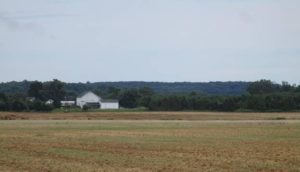
2017, August 6, Sunday — A view of the cuesta from the Union Transportation Trail in Upper Freehold, Monmouth County. The view is looking toward the Shore, so the abrupt rise in the terrain is seen. From the other side of the cuesta, the change in terrain is more gradual.
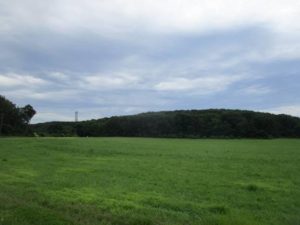 2017, August 6, Sunday — Another view of the cuesta – here, near the Horse Park of New Jersey in Upper Freehold, Monmouth County.
2017, August 6, Sunday — Another view of the cuesta – here, near the Horse Park of New Jersey in Upper Freehold, Monmouth County.

2016, January – Looking at the cuesta, about 200 feet above sea level, across Sandy Hook Bay from Sandy Hook.
BUTTERFLIES IN THE ZINNIA PATCH: Last year, my newspaper reporting travels took me to Bobby Laurino’s farm market in Colts Neck and Andy Capelli’s farm market in Middletown. I was amazed by the bees and butterflies attracted to their zinnia patches. Here was this abundance of pollinators and they were fun to watch. So, I did some research on zinnia – liking it because it is an annual, not a perennial I would be stuck with – and planted it in my garden, about 35 to 40 row feet. I wish I planted more! In recent days, I have spotted these butterflies: painted lady, “Vanessa cardui”; spicebush swallowtail, “Papilio troilus”; cabbage white, “Pieris rapae”; silver-spotted skipper, “Epargyreus clarus”; and monarch, “Danaus plexippus.” I try to become one with the zinnia patch, or at least letting the butterflies do their thing and me doing my thing, which allows me to get close to them and take great photographs.
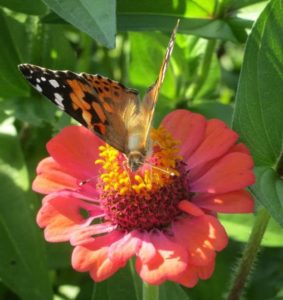
A painted lady butterfly in my zinnias.
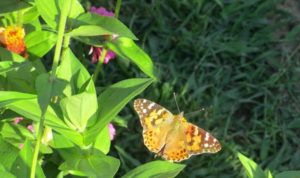
Painted lady in the zinnias.

Painted lady on a zinnia.
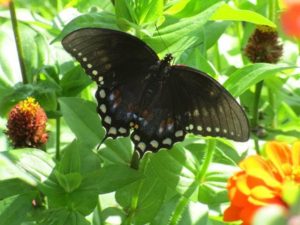
Spicebush swallowtail in the zinnias.
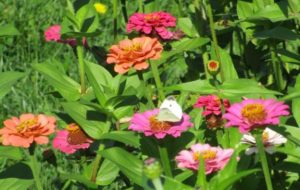 Cabbage white in the zinnias.
Cabbage white in the zinnias.
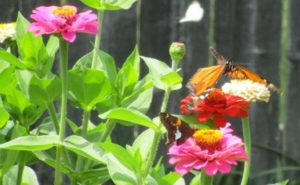
Silver-spotted skipper, lower, and monarch, upper, in the zinnias.
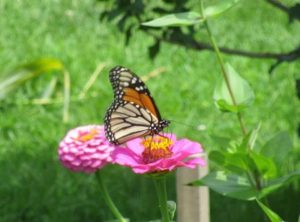
Monarch in the zinnias.
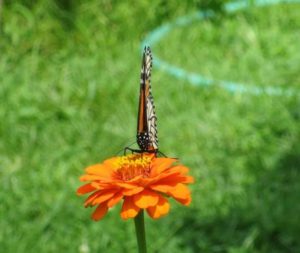
Monarch on a zinnia.
SOURCES, BUTTERFLIES: I love this Internet site of the North American Butterfly Association (NABA)-North Jersey Butterfly Club for identifying butterflies, http://www.naba.org/chapters/nabanj/butterflies.html.
GARDEN VOICE NO. 1, DEBBIE MANS: Debbie Mans reported, “We were just comparing notes at work on our gardens and we are all not seeing great results — split tomatoes, fizzled squash, slow on the tomatoes ripening, etc. This is in Monmouth County and Essex County. I am hearing more and more from others, too. You are not alone!” (Debbie is executive director and baykeeper for the New York-New Jersey Baykeeper environmental group based in Keyport, Monmouth County. Here is a profile I wrote of Debbie last year, http://tworivertimes.com/debbie-mans-midwesterner-with-jersey-sand-in-her-shoes/.)
NAVESINK RIVER BOAT RIDE: Debbie Mans’s New York-New Jersey Baykeeper group is sponsoring a Navesink River boat ride September 19, Tuesday, out of Atlantic Highlands, Monmouth County. Last year, I sailed with the Baykeeper on a Sunday afternoon on Raritan Bay and the Shrewsbury River – a great time! So, if free, consider the Navesink River ride. Monmouth County’s Navesink River, one of my favorite places in the Jersey Midlands as it flows along the cuesta emptying into the Shrewsbury River. For the Navesink River Sunset Eco Cruise.
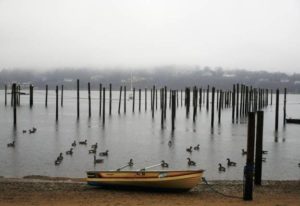
2015, December – Along the Navesink River.
GARDEN VOICE NO. 2, JACK MAHON: South Jersey gardener Jack Mahon and I recycle dehumidifier water, using it for gardening watering. But, this year, both Jack and I have noticed something – the heavy rains have left us with an overabundance of water. “The rain has been so heavy at times that the dehumidifier is way ahead of the trees’s need for water,” Jack said. Ditto. In recent days, my two barrels of water for the garden, totaling 50 gallons, have been full.
IN THE GARDEN AND YARD: I continued harvesting flowers, both zinnias and Knock Out roses, along with sweet corn. The fall crop is sprouting. And I watch the cucumbers and cantaloupe, hoping something comes about. The cantaloupes look OK as they grow, but the cucumbers seem to be victims of too much rain and I wonder if I will even get one to use.
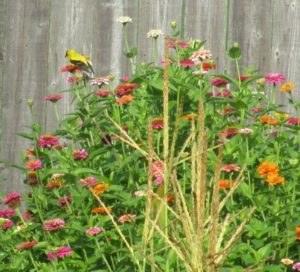
A male Eastern goldfinch, “Spinus tristis,” perched on a zinnia flower in the garden.
MONROE TOWNSHIP COMMUNITY GARDEN: I visited my lifelong hometown’s Community Garden and Park. It is a nice setting along the Millstone River. But I wish Monroe, which continues to develop heavily, would practice greener principles. For example, abandon magazine-photograph lawns and replace them with more productive organic gardens. Me, I am trying to go with as little lawn as possible – and my lawn is chemical-free. I know, I strive for an Old Monroe in a New Monroe whose population over its approximately 42 square miles is an estimated 45,000, a big difference from the estimated 5,000 when I was born in 1956.
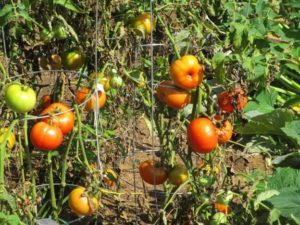
Tomatoes in the Monroe Community Garden and Park.
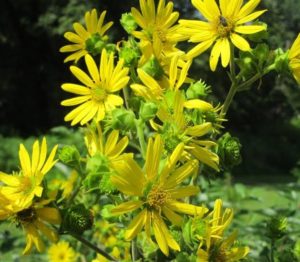
Flowers at the Monroe Community Garden and Park.
THE ECLIPSE OF THE SUN: On Monday, August 21, New Jersey will be treated to a partial solar eclipse. It begins at 1:22 p.m., peaks at 2:44 p.m., and ends at 4 p.m. DO NOT LOOK AT THE ECLIPSE UNLESS YOU HAVE SPECIAL PROTECTIVE EYEWEAR. (While I find the eclipse exciting, I do not want to take chances of looking up. So, I will take a nap, work in my cellar or garage, or follow the eclipse on the computer or television.) See https://eclipse2017.nasa.gov/.
CARDINAL PHOTO: The photo of a cardinal, “Cardinalis cardinalis,” in last week’s “Garden and Afield” drew a nice response from backyard neighbor Fran D’Aiello Rosuck. Fran and her husband, Ed, have been my family’s neighbor for about 40 years, or since about the time I went on my own after college. Then, after my parents, Joe Sapia Sr. and Sophie Onda Sapia, died, I, as an only child, moved back and took over the house. This summer, the outside of the house was remodeled. Fran said, “I always read that a cardinal is a visitor from Heaven. Your mom is probably saying the house never looked so good.” What a nice comment to find on my “The Jersey Midlands” page on Facebook.com.
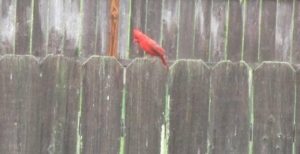
The cardinal at my garden. Actually, it is on backyard neighbor Fran D’Aiello Rosuck’s fence.
OCEAN TEMPERATURES: Atlantic Ocean temperatures on the New Jersey coast were in the range of about 75 to 77 degrees.
SUNRISE/SUNSET: For August 20, Sunday, to August 26, Saturday, the sun will rise about 6:15 to 6:20 a.m. and set about 7:40 to 7:50 p.m. For August 27, Sunday, to September 2, Saturday, the sun will rise about 6:20 to 6:25 a.m. and set about 7:30 p.m.
WEATHER: The National Weather Service forecasting station for the area is at http://www.weather.gov/phi/.
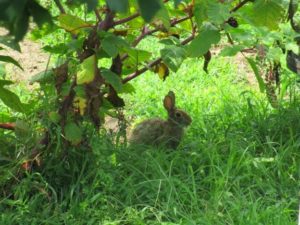 Rabbit, genus “Sylvilagus,” in the garden.
Rabbit, genus “Sylvilagus,” in the garden.
Joe Sapia, 60, is a lifelong Monroe resident. He is a Pine Barrens naturalist and an organic vegetable-fruit gardener. He gardens the same backyard plot as did his Italian-American father, Joe Sr., and his Polish-immigrant, maternal grandmother, Annie Poznanski Onda. Both are inspirations for his food gardening. Joe is active with the Rutgers University Master Gardeners/Middlesex County program. He draws inspiration on the Pine Barrens around Helmetta from his mother, Sophie Onda Sapia, who lived her whole life in these Pines, and his Grandma Annie. Joe’s work also is at @JosephSapia on Twitter.com, along with Facebook.com on the Jersey Midlands page.
Article and photos by Joe Sapia
Note: The yard references are to my house in the section of Monroe between Helmetta and Jamesburg in South Middlesex County. My yard is in a Pine Barrens outlier on the Inner Coastal Plain, the soil is loamy, and my neighborhood is on the boundary of Gardening Zones 6b (cooler) and 7a (warmer). Notes and photographs are for the period covered, unless otherwise noted.
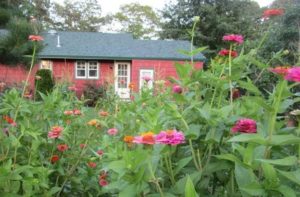
Looking across my backyard garden to the Knock Out roses and the house.
IN THE GARDEN: I began harvesting sweet corn – it tastes so good! I continued harvesting zinnia, mostly giving them away. Because zinnia are so beautiful, make nice bouquet gifts, and are so attractive to pollinators, I plan to really expand on growing them next year, taking over what is now a waste of lawn. I finished planting seeds for fall crops of beets, carrots, lettuce, and peas. Including early season, summer and fall crops, my garden is about 450 row feet. I began keeping a record of my harvest, so I have an idea how productive the garden actually is. Next year, I plan to keep the record from Day 1 harvest to Last Day harvest.
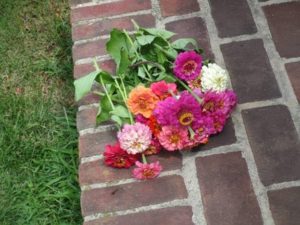
A zinnia bouquet heading to friends at my Sunday lunch stop, the Hightstown Diner.
A BAD GARDENING YEAR: I thought my garden was bombing out because of my lack of skills, but I continue to get reports of it not being a productive vegetable year. Paul Migut, a childhood friend and a gardening mentor of mine, checked in from South River, Middlesex County: “Agree, not one of the best garden years, here either.” Jack Mangano of Helmetta told me his family’s plot is not doing as good as it should. The weather has been fickle, one day monsooning, another day sunny and in the 90s – seemingly more fickle than a normal Jersey hot and humid summer with thunderstorms in the afternoon. I found a split cucumber, which, I suspect, was a victim of the rain – the rain forcing it to grow faster than it was able to maintain, resulting in it finally bursting.
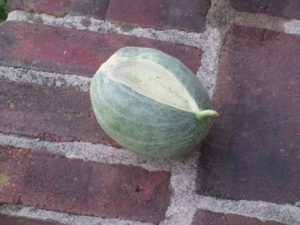
A split and ill-forming cucumber, an apparent victim of too much rain.
GARDENING TALK: Paul Migut reported on his garden: “Bush beans producing the best. Cucumbers growing well (made second batch of dill pickles in my grandmother’s 100-year-old old crock). Rutgers tomatoes getting bigger, but still green. Yellow (acid-free) almost ready to pick. Eggplants, too small to pick. Zucchini started out with a bang, until worm/borer devoured base of plant. By accident, I purchased a packet of turnip seeds, never grew these before, but wow- growing very well!”
ELSEWHERE AROUND THE YARD: I took off from feeding the birds this summer, letting them, instead, eat insects in the yard and serve as natural pesticides. So, I have not kept the eye I normally do on birds, mesmerized by them at the feeder. However, I did notice a bright yellow and black (male) Eastern goldfinch, “Spinus tristis”; a bright red (male) cardinal, “Cardinalis cardinalis”; and a favorite, a catbird, “Dumetella carolinensis” – the catbirds that keep me company in garden and afield. The toads are around, presumably helping control insects. I helped a toad out of a deep well of cellar window that was recently installed. I place a branch in the well; If a toad goes in, hopefully it can crawl out on the branch – because by the time I notice it, it may be too late. Of course, the friendly rabbits are around – letting me get close and probably eating up the garden. And the Knock Out roses, in their second bloom of the season, are getting better and better.
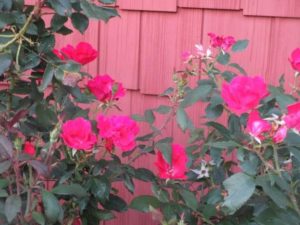
Knock Out roses are blooming beautifully in their second bloom of the season.
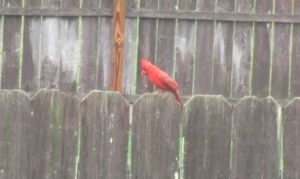
A male cardinal perched by the garden. A male, because it is bright red. The female is a dull brown.
ATTRACTING POLLINATORS, ZINNIA: While I love the beauty and no-fuss growing of zinnias, my real goal for planting them this year was to attract pollinators. This week, pollinators were around:

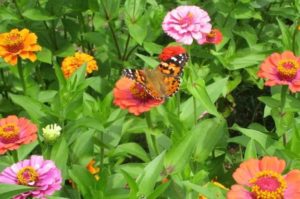
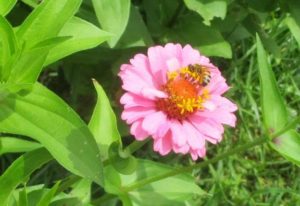
PERSEID METEOR SHOWER: The forecasted weather is not looking good, but take a chance and look up into the night sky on the overnights of August 11-12, Friday-Saturday, or August 12-13, Saturday-Sunday, the peak of the annual Perseid Meteor Shower. If there is a clear sky, an estimated 40 to 50 “shooting stars” will be visible per hour. The Earth will continue passing through Comet Swift-Tuttle’s path until August 24. See www.space.com/32868-perseid-meteor-shower-guide.html.
THE DRIVE-BY NATURALIST, ROADKILL: I was driving south on Route 539 in East Windsor, Mercer County, heading for the Assunpink Wildlife Management Area, when I came across an interesting sight -– vultures, both turkey, “Cathartes aura”, and black, “Coragyps atratus,” eating a roadkill deer, “Odocoileus virginianus.” It was an interesting study in nature, the death of one animal providing life-support to other wildlife. But it also was an interesting interaction between wildlife and humans – basically, traffic had to avoid the vultures, rather than the vultures making a serious attempt to avoid traffic. What did I take away from this scene? The importance of us helping living wildlife by moving dead wildlife off the roadway, because other birds may not be so lucky squaring off against traffic at a roadkill. A live bird could end up as roadkill.
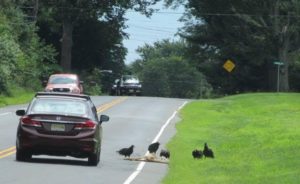
Notice how traffic has to move to avoid the vultures, while the vultures generally were carefree.
DRIVE-BY NATURALIST, NO. 2 – TURKEY VULTURES VS. BLACK VULTURES: Turkey vulture, red head, long tail. Black vulture, black head, short tail. (Note: I do not recall seeing a black vulture locally until probably the 1990s. They are a southern species that has moved northward.)
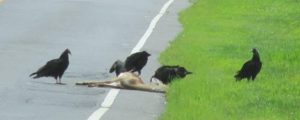
Turkey vulture, far left, with a red head and longer tail. Black vulture, far right, with short tail and black head.
CONNECTING WILDLIFE HABITAT: The state Department of Environmental Protection’s Endangered and Nongame Species Program has been working on a project, CHANJ, or Connecting Habitat Across New Jersey, which is aimed at creating wildlife habitat connectivity, since about 2012. The plan is to make a public push in 2018. CHANJ is looking to protecting habitat and connecting habitat through such things as land purchase, management of land, and safe wildlife passage at roadways. Roadway mitigation could include using culverts and bridges to have a safe pathway for wildlife to cross roads. The idea is have connectivity using core areas, which could be as little as 200 acres to as big as state regions such as the Highlands of North Jersey and, locally, the Pine Barrens. Core is “an area with high ecological integrity,” said Gretchen Fowles, a CHANJ biologist. “That’s a fancy way of saying it has little human influence,” she said. In Monmouth County, for example, beside the Pine Barrens as a region, CHANJ looks at cores as such places as the Navesink River, Manasquan River Reservoir, Shark River, Allaire State Park, the Turkey Swamp state- and county-owned properties, Monmouth Battlefield State Park, and Assunpink Wildlife Management Area. Then, the idea is to connect such areas as forest, field, freshwater wetlands, and coastal maritime habitats. “This might be kind of a last chance to keep areas protected and intact,” Fowles said. The CHANJ website is at http://www.state.nj.us/dep/fgw/ensp/chanj.htm. Also, a CHANJ video is at https://www.youtube.com/watch?v=6UbBcTUfz1U.
MUSHROOMS: Remember the adage, “There are old mushroom pickers. There are bold mushroom pickers. There are NO old AND bold mushroom pickers.” Me, 60-years-old, lifelong Jersey Midlands, from a maternal Polish-Slovak family of pickers going back here more than 100 years and I will comfortably pick only 2 mushroom species: honey (or “opienki,” as my Polski side calls them), genus “Armillaria,” and morels genus “Morchella.” My confidence in only those 2 comes from being taught by two smart, non-bold pickers. Because this time of year is popular for wild mushrooms: http://www.philly.com/philly/health/n-j-mushroom-poisonings-spike-some-potentially-life-threatening-20170808.html
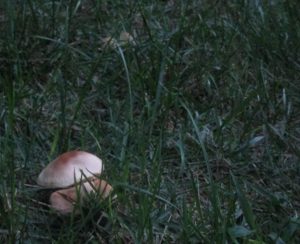
Inedible mushrooms in my yard.
“FALL” FOLIAGE: In the Pine Barrens around Helmetta, the beginning of the “fall” foliage usually is obvious in swamps beginning about July 15 to July 31. So, no surprise I have seen a few examples.
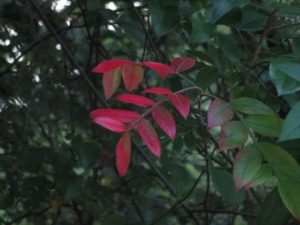
Changing colors in the Helmetta Pond wetlands.
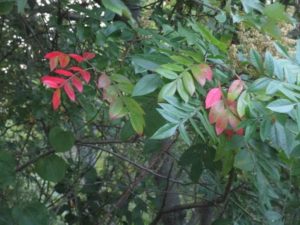
Another view of the changing colors in the Helmetta wetlands.
OCEAN TEMPERATURES: Atlantic Ocean temperatures on the New Jersey coast were in the range of about 76 to 78 degrees Thursday, August 10.
UPCOMING COUNTY FAIRS: Middlesex County Fair concludes August 13, Sunday, in East Brunswick, http://middlesexcountyfair.com/. Hunterdon County 4-H and Agricultural Fair, August 23, Wednesday, to August 27, Sunday, http://www.hunterdoncountyfair.com/.
OTHER UPCOMING: August 21, Monday, solar eclipse. September 9 and 10, Saturday and Sunday, 10 a.m. to 5 p.m., the state Department of Environmental Protection’s Wild Outdoor Expo at the Colliers Mills Wildlife Management Area, Jackson, Ocean County, WildOutdoorExpo.com.
SUNRISE/SUNSET: For Aug. 13, Sunday, to August 19, Saturday, the sun will rise about 6:05 to 6:15 a.m. and set about 7:50 p.m. to 7:55 p.m. For August 20, Sunday, to August 26, Saturday, the sun will rise about 6:15 to 6:20 a.m. and set about 7:40 to 7:50 p.m.
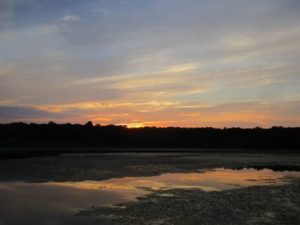
Sunset at Helmetta Pond.
WEATHER: The National Weather Service forecasting station for the area is at http://www.weather.gov/phi/.
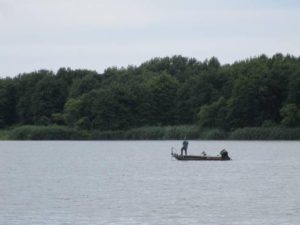
Assunpink at the Assunpink Wildlife Management Area, here in Monmouth County
Joe Sapia, 60, is a lifelong Monroe resident. He is a Pine Barrens naturalist and an organic vegetable-fruit gardener. He gardens the same backyard plot as did his Italian-American father, Joe Sr., and his Polish-immigrant, maternal grandmother, Annie Poznanski Onda. Both are inspirations for his food gardening. Joe is active with the Rutgers University Master Gardeners/Middlesex County program. He draws inspiration on the Pine Barrens around Helmetta from his mother, Sophie Onda Sapia, who lived her whole life in these Pines, and his Grandma Annie.
Joe’s work also is at @JosephSapia on Twitter.com, along with Facebook.com on the Jersey Midlands page.
Article and photos by Joe Sapia, except as noted
Note: The yard references are to my house in the section of Monroe between Helmetta and Jamesburg in South Middlesex County. My yard is in a Pine Barrens outlier on the Inner Coastal Plain, the soil is loamy, and my neighborhood is on the boundary of Gardening Zones 6b (cooler) and 7a (warmer). Notes and photographs are for the period covered, unless otherwise noted.

This scene, on August 2, Wednesday, at the Sears department store in New Brunswick, Middlesex County, kind of sums up this summer’s weather: alternating pouring rain and blue sky.
FARRINGTON LAKE: I love kayaking Farrington Lake on the boundary of South Brunswick, North Brunswick, and East Brunswick, all in Middlesex County. It is slender, about 3-1/2 miles long. Because there is so much forest lining the shores, it has a feel of being in the Adirondacks or some other place that is remote, rather than on the edge of suburbia as it is. This week, I did not kayak, but simply stopped to grab some quick photographs. Of course, the lake, created by the damming of Lawrence Brook basically between Davidson Mill Pond Park and Milltown, is beautiful, but I also saw a beautiful flower, purple loosestrife, “Lythrum salicaria.” The problem is purple loosestrife is non-native, highly invasive species, clogging the wetlands ecosystem. On the bright side, I was entertained by swallows. They fluttered around the lake, searching for bugs to eat.
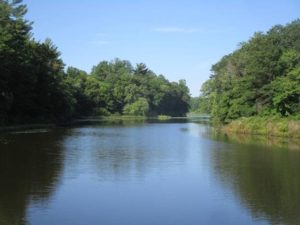
Farrington Lake, looking south toward Route 130 from the Church Lane bridge.
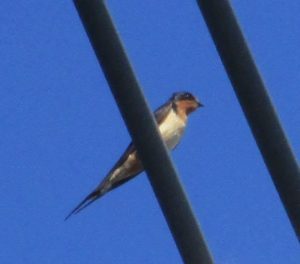
A barn swallow, “Hirundo rustica,” perches on a utility line above Farrington Lake.
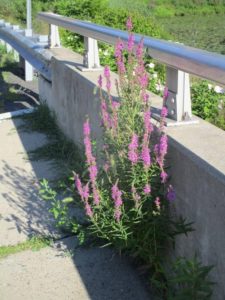
Purple loosestrife, even coming up through a crack in the sidewalk on the Church Lane bridge crossing Farrington Lake.
IN THE GARDEN: Cucumbers, cantaloupe, sweet corn, and tomatillos continue to grow, not yet ready to harvest. Remember me mentioning how I did not plant the tomatillos? Well, now, the garden is sprouting what appears to be gourds, which I did not plant. The zinnias continue to bloom wonderfully. And looking to the fall, I planted carrots. I went to Tony’s Farm and Garden Center in Robbinsville, Mercer County, and picked up more seeds for a fall crop: Detroit Red Medium Top Beets, Touchon Heirloom Carrots, Sugar Snappy Peas, Sugar Daddy Heirloom Peas, and Snowbird Peas, all Burpee brand.
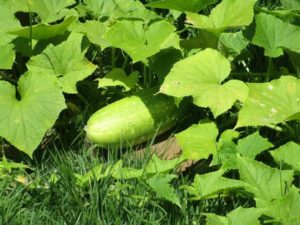
Here come the cucumbers. I place a brick underneath the cukes and mushmelons to keep them from having contact with the ground, leading to rot.
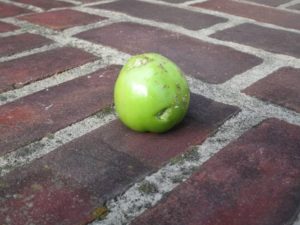
Which one of my yard friends bit into this green tomato?
GARDEN TALK: While at Tony’s Farm and Garden Center, I got talking to Tony Ciacco, the third generation of the Ciacco family to own and run the center. Tony mentioned the lack of bees in the environment, as we stood in amidst rows of flowers. Among those flowers, few, if any bees, which act as pollinators, flew around. In the past, the center would warn customers of bees flying around its greenhouses, Tony said. Later that afternoon, neighbor Tom DeRose and I stood in my zinnia patch. The zinnia patch noticeably has butterflies moving from flower to flower, but hardly any bees. We are in real trouble if we measure pollination by bees. Tom also mentioned his garden is having a bad year for carrots with a lot of green but little fruit. My carrots, too, are not doing great – some with clusters of nice carrots, some with lots of green but not good carrot production.
COLOR AT TONY’S: When I go to Tony’s Farm and Garden Center, I try to shoot photos because there is a lot of color in the plantlife.
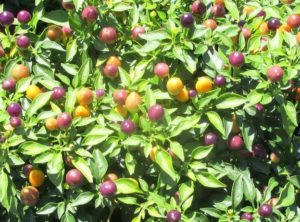
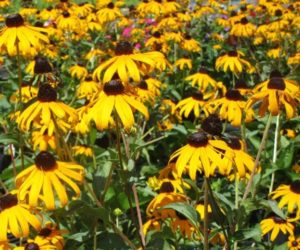
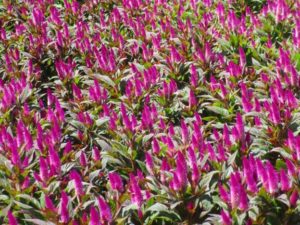
BALD EAGLES: I got a report of bald eagles, “Haliaeetus leucocephalus,” having a nest this season along the Raritan River just north of downtown New Brunswick. Also, the state Department of Environmental Protection confirmed a nest, which fledged one chick, in my hometown of Monroe. So, I have been keeping an eye out for eagles flying around near that nest, which is in the area of Route 33 and Applegarth Road/Butcher Road.
ORCHIDS IN THE PINE BARRENS: Faye Bray, a friend and outdoorswoman who lives in the main Pine Barrens, comes through again with beautiful reports of orchids. This time, the white-fringed, “Habernaria blephariglottis,” and the yellow-fringed, “Habernaria ciliaris.” Both were found recently in the Oswego Lake, Burlington County, area of the main Pine Barrens.
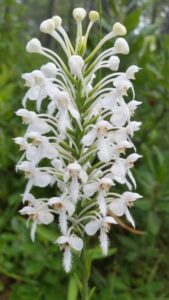
White-fringed orchid in the Oswego Lake area, Burlington County, of the Pine Barrens. (Photo copyright 2017 by Faye Bray.)
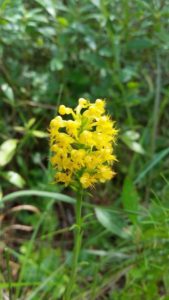
Yellow-fringed orchid in the Oswego Lake area of the Pine Barrens. (Photo copyright 2017 by Faye Bray.)
LOW MOISTURE IN THE AIR: When I am out in the garden, or the yard in general, I try to observe the world around me – basically the woods around me, The Swamp down the street, and the sky. As for the sky, on July 30, Sunday, Joey Slezak, a meteorologist and my go-to science guy in Helmetta, texted me, “Bluebird skies this morning! Low humidity!” Yes, the sky had that clear look to it because moisture was not clogging up the air. A great day to do yard work. I texted back, “Going out to cut lawn, camera in hand.” On days such as this, it feels as though one could reach up and touch airplanes passing by.

A JetBlue Airbus cruises by at about 240 knots at approximately 4,800 feet on its way from Fort Lauderdale, Florida, to Newark, Essex County. (How do I know the details on this aircraft? From following my new obsession, www.flightradar24.com.)
OBSESSION, NO. 2, WATERING THE GARDEN: In recent days, I have gone from daily watering (except when for days when it is raining) to more sporadic watering. If nothing else, I was worried the cantaloupe and sweet corn were getting too much water, especially because of the recent rain.
GRANDMA’S WATERING CANS: Normally, I water the garden using house water with hose and sprinkler. When I accumulate enough water in my water barrels, which can hold 20 gallons and 30 gallons, I use sprinkling cans I had around the house. At least one of them is Grandma Annie Onda’s. The other one, if not Grandma’s, was Ma and Pops’s. Those watering cans must date to the 1960s or earlier. One of them has a pretty severe leak. But they are still being put to good use. (Grandma, Ma, and Pops are deceased — Grandma in 1972, Ma in 1995, and Pops in 2006 — but their implements around the house are still being used by me.
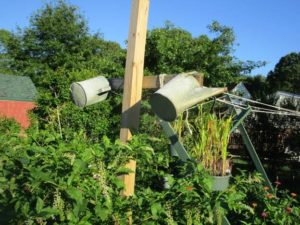
The old watering cans.
MORE WATERING WAYS: Jack Mahon – a South Jersey gardener, naturalist, and birder – shared his watering ways: “First, basement de-humidifier drains to bucket in sink. Milk jugs are filled from bucket. If we’re away, I just let it (the dehumidifier) drain directly into the sink. Next, jugs on back deck. Some have white caps, some pink. The pink ones would have a very diluted liquid plant food that I use in the first half of the season. Right now, though, they are 100 percent water. At end of August, I’ll start another very weak fertilizer routine, phosphorus & potash rather than the spring nitrogen-based. Finally, four of the crop, American beech, crepe myrtle, black pine, and willow oak. I only bother with hardy varieties that can overwinter in a cold frame.”
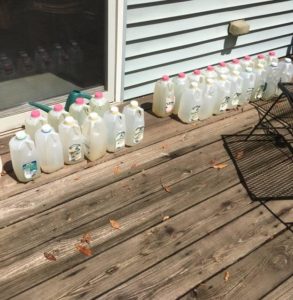
Jack Mahon’s recycled de-humidifier water to be used for potted trees he is raising. White caps mean pure water. Pink caps mean water diluted with plant food. (Photos supplied by Jack Mahon.)
BOOKS FOR THE JERSEY MIDLANDS NATURALIST, NO. 2: Years ago, I picked up a valuable book at New Jersey Audubon’s Owl Haven nature center at Monmouth Battlefield State Park in Monmouth County – “New Jersey Wild Plants” by Mary Y. Hough, a plant ecologist and taxonomist, 1983, Harmony Press, Harmony, N.J. The book lists plantlife alphabetically by its scientific name. So, most of us probably would need to use another source using common names, then check Mary’s book. As Rutgers University botanist David E. Fairbrothers wrote in the book’s preface, “This publication was designed as a New Jersey supplement for current field guides and technical manuals. …Included are all native and introduced species of club mosses, conifers, ferns, flowering plants, horsetails, quillworts, and spikemosses growing without cultivation in the state. …It is indeed a welcome addition for professional and non-professional biologists and/or naturalists, because it provides information about species for the entire state, much of which is not available or scattered in many sources, because of a lack of a “Manual of the Flora of New Jersey.” Mary Hough deserves our appreciation for having produced a useful information source about the interesting flora of a very floristic geographical area….” What I love about this book is it tells New Jersey bloom times, lists habitat and general state locations for finding the species, and gives a tidbit of more information such as the plant being poisonous or a little of the history in finding the plantlife. Owl Haven is long gone, but Hough’s book still proves invaluable. It is one of the most-used books in my outdoors collection. (Note: One, books mentioned in this series may be out of print. Two, Dr. Fairbrothers, now deceased, was a very informative and kind mentor of my pursuits in the Spotswood Outlier of the Pine Barrens.)
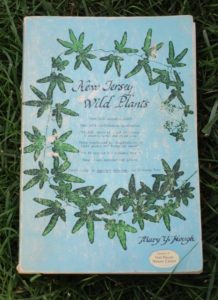
Mary Y. Hough’s “New Jersey Wild Plants”

Y. Hough’s “New Jersey Wild Plants.” Here, the listings for sheep laurel, “Kalmia angustifolia,” and mountain laurel, “Kalmia latifolia.”
MUSHROOMS: I have seen some chatter regarding the edibility of mushrooms on a Pine Barrens Facebook page I follow. I am 60-years-old and lifelong Jersey Midlands and I feel comfortable picking only two types of mushrooms. I will not identify them for this conversation because I do not want to confuse anyone on what is edible. So my basic advice, only feel safe eating a locally found mushroom if a COMPETENT picker OKs it. Remember the adage: “There are old mushroom pickers. There are bold mushroom pickers. There are no old AND bold mushroom pickers.”
CLOUDS: Over the last several months, we have been blessed with beautiful views of cloudy skies…
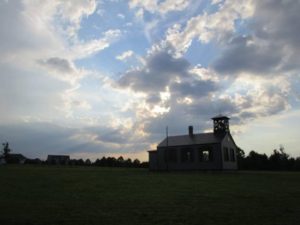
At the Dey Farm Historic Site in Monroe.
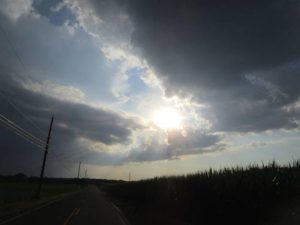
Farmland at the Applegarth section of Monroe.

At the Johnson and Johnson clock tower in New Brunswick.
IN THE YARD, ROSES: There seems to be a sporadic, but beautiful, bloom on the “Knock Out” roses in my backyard. So, I will call this a continuation of the second bloom of the season, rather than a third bloom. The rose bushes did get somewhat battered during the recent outside remodeling of my house that lasted from mid-June to late July. Perhaps that is the reason for sporadic blooming.
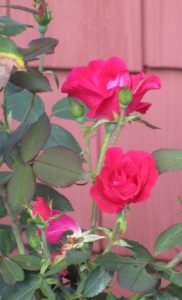
The “Knock Out” roses in bloom in the backyard.
OCEAN TEMPERATURES: Atlantic Ocean temperatures on the New Jersey coast were in the range of 73 to 76 degrees on Saturday, August 5.
UPCOMING COUNTY FAIRS: Middlesex County Fair, August 7, Monday, to August 13, Sunday, in East Brunswick, http://middlesexcountyfair.com/. Somerset County 4-H Fair, August 9, Wednesday, to August 11, Friday, in Bridgewater, http://www.somersetcounty4h.org/fair/. Hunterdon County 4-H and Agricultural Fair, August 23, Wednesday, to August 27, Sunday.
OTHER UPCOMING: There will be a solar eclipse August 21, Monday.
SUNRISE/SUNSET: For Aug. 6, Sunday, to August 12, Saturday, the sun will rise at about 6 to 6:05 a.m. and set about 8 to 8:05 p.m.
WEATHER: The National Weather Service forecasting station for the area is at http://www.weather.gov/phi/.
JOEY’S WORLD: On Saturday, August 5, I found one of my garden buckets filled with water and thought, When did it rain hard? But neighbor Tom DeRose informed me the neighborhood had a severe thunderstorm after midnight and before dawn. We did? Oh, boy, I must have pretty much slept through it.
SCREEN TENT: A few weeks back, I ordered a Coleman screen tent. I wanted a simple way to enjoy the backyard without mosquitoes biting me. I had to wait for the remodeling contractors to be gone, before I could regain control of my yard, including putting up the tent. What a buy for about $60 or so dollars. I did write much of this blog in the tent. Now, to find more time to enjoy the tent.
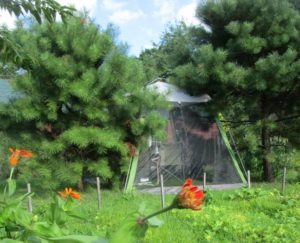
The screen tent nestled between two pitch pines, “Pinus rigida,” the food-flower garden, and lawn.
A PLAN FOR NEXT YEAR: Simply, as little lawn as possible. Translated, more space for growing food and zinnias, less grass for me to cut.
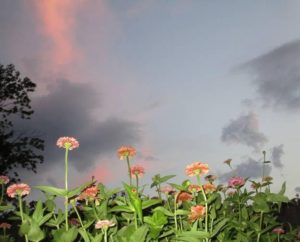
Beautiful zinnias in the garden and a beautiful sky in the background.
Joe Sapia, 60, is a lifelong Monroe resident. He is a Pine Barrens naturalist and an organic vegetable-fruit gardener. He gardens the same backyard plot as did his Italian-American father, Joe Sr., and his Polish-immigrant, maternal grandmother, Annie Poznanski Onda. Both are inspirations for his food gardening. Joe is active with the Rutgers University Master Gardeners/Middlesex County program. He draws inspiration on the Pine Barrens around Helmetta from his mother, Sophie Onda Sapia, who lived her whole life in these Pines, and his Grandma Annie. Joe’s work also is at @JosephSapia on Twitter.com, along with Facebook.com on the Jersey Midlands page. Copyright 2017 by Joseph Sapia




















































































































